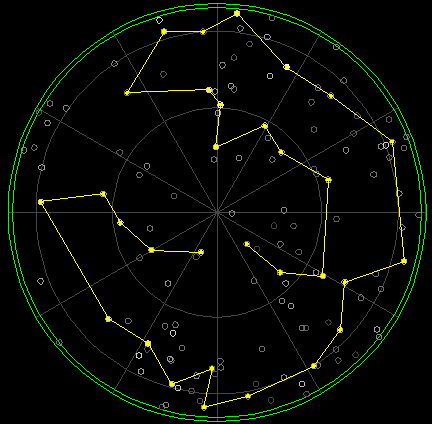Baseline solutions
A baseline solution is a calibration that is performed on an interferometer. It basically is an procedure to measure the distances between interferometer elements and to learn their exact placings.
What are we trying to determine?
Basically, the stations of the ATCA already have surveyed positions. The baseline solution attempts to determine the offsets to these positions is X-Y-Z coordinates. These offsets are placed in a file which are read by the observing program CAOBS.
A cm baseline solution needs to be calculated after every reconfig. If mm observations are scheduled in the configuration, a mm solution needs to be calculated as well.
A baseline solution assumes that the atmosphere will be stable over the time
of the observations: Thus, the best time for the solution is at least an hour
after sunset. If in doubt, check the phase stability by tracking a phase
calibrator (the phase needs to be not be varying by more than a few degrees)

Baseline solution procedure
cm Baseline Prodedures
- Generate a schedule using
srcpac.
The schedule include the following:- 35-45 sources.
- Have good HA/DEC coverage (as far as is possible given the constraints of the array and shadowing)
- Consideration of antenna wraps to avoid long travel times.
- Sources should typically be less than 15 degrees from each other to minimise the chance of phase ambiguity in the solution.
- Load the schedule into
caobsand calibrate the delays and phases (and amplitudes if you like) with
caobs> corr dcal aand
caobs> corr pcal a
Notes: It is important to ensure that the delays are stable, as the delay offsets are now used to help determine phase wraps.
If there are delay jumps, check for interference andfflagincabbif necessary. - In a seperate
xbonesterminal, run cabsln with
xbones> cabsln
The defaults to all questions are should work for most situations. Scantype B is the normal scantype for baseline scans.
Note: Only the first frequency is used bycabsln - Start the observations with scan 2 of a
srcpacschedule:srcpacsets the scantype of the first scan to be 'C' and expects that calibration be done with that scan. Subsequent scans have scantype 'B'.cablsnuses the 'B' scantype to indicate that this source is to be used for baseline calibration - scantype 'C' will be ignored. - When there is good sky coverage,
cabslnshould be giving stable offsets with a phase error of < 10°. This will depend on the weather and frequency. In poor weather (in summer) the error may be larger (but hopefully < 20°. - Write this solution to file and generate a plot for later reference:
cabsln> wwrites the file
cabsln> pgenerates a plot
cabsln> qquits fromcabsln
The solution should be saved in the text filescabsln.datandcablsn.txt. The.datfile is in the format expected by the observing software. The.txtfile is in the format that is recognised bymiriadand is used byuveditto apply a different solution. - To apply this solution,
- copy the file to
$ATCA_INIT/station_errors.filewith:
xbones> cp cabsln.dat $ATCA_INIT/station_errors.file - incorperate it into the
cabbworld with:
caccc1>~/bin/ApplyApplyBslErrors
- copy the file to
- Check that the solution is good by observing a few sources across the sky
mm Baseline Prodedures
The mm observations are done in a similar way to the cm observations, however, the
data reduction needs to be done in miriad
- Create a schedule using similar criteria to the cm solution
- Change the frequencies to 17000 and 19000 using global change in the
CABBscheduler - Take the data (take care to ensure that the phases are close to 0°rees at the start
- Reduce the data using blfit
Original: Derek McKay (21-Feb-1995)
Modified: Robin Wark (24-Jun-2009)
